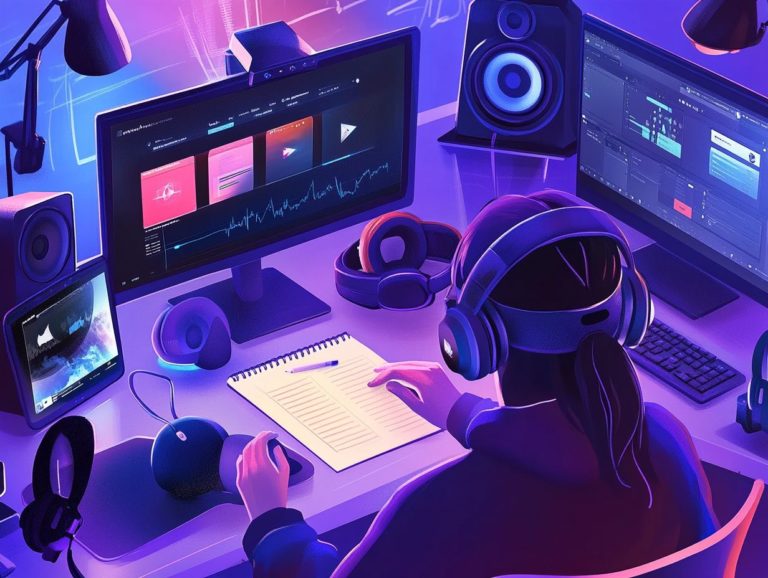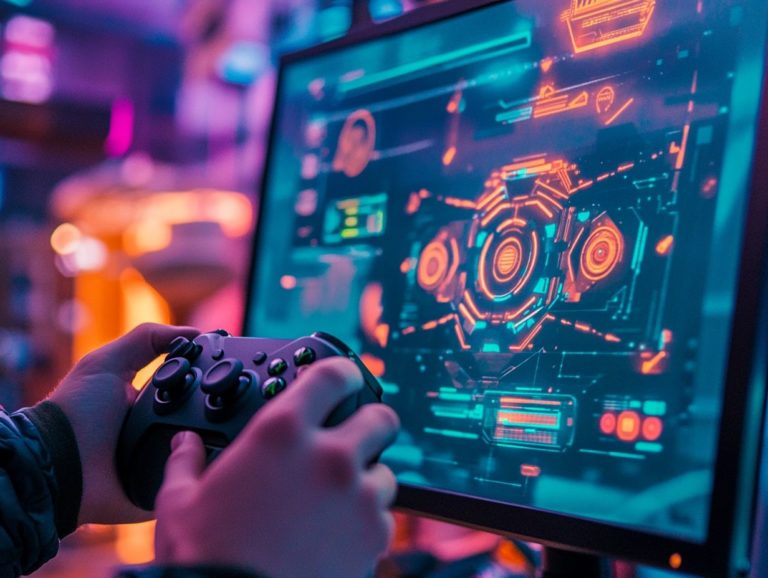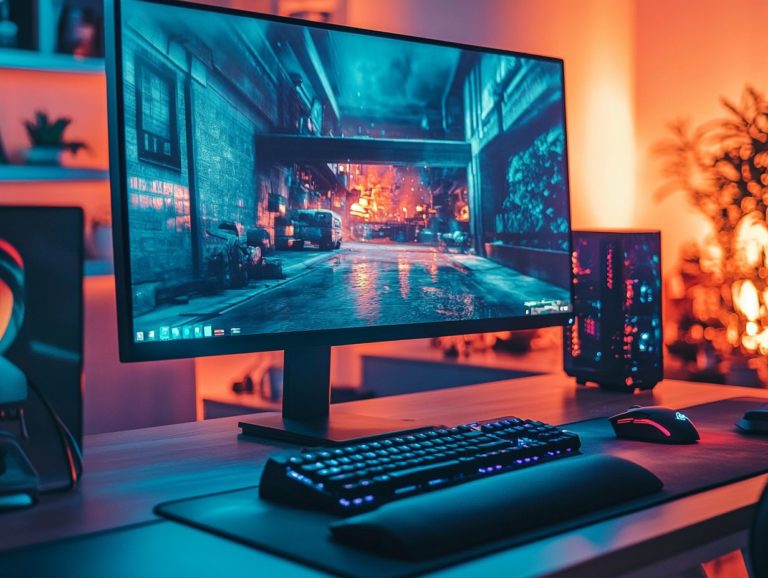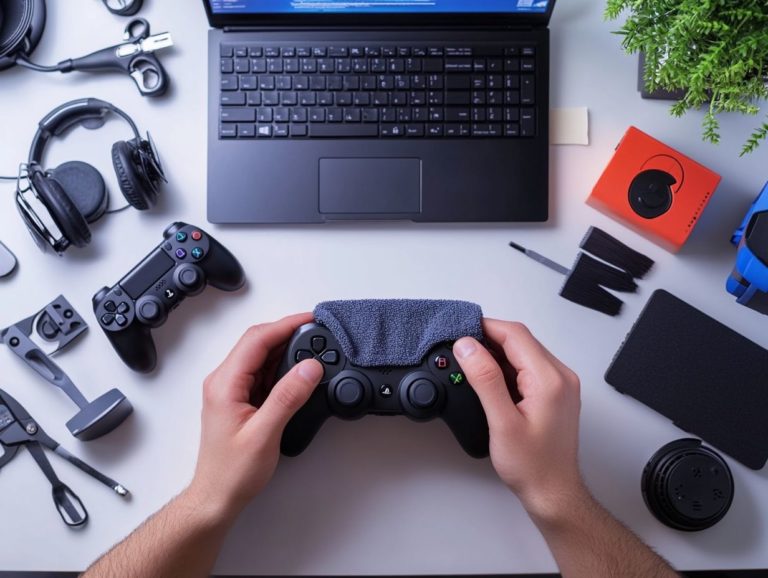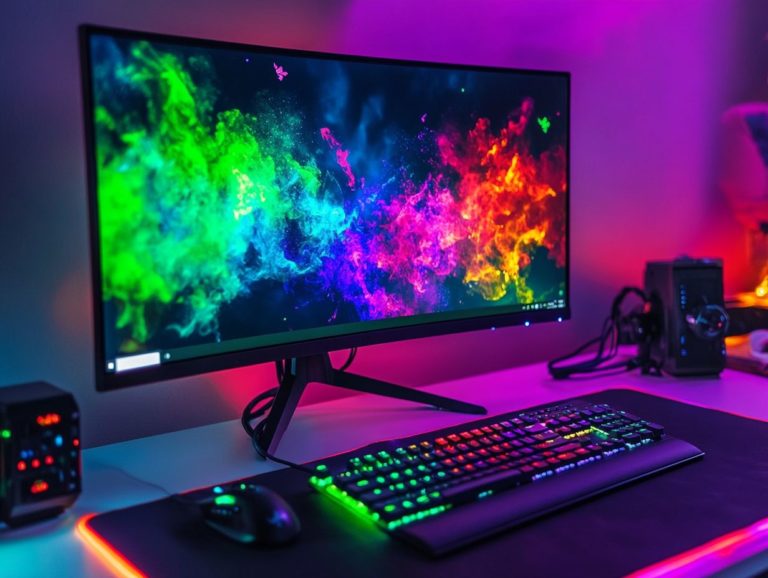how to choose the right monitors for multi-display setup?
Multi-display setups are increasingly popular in today s fast-paced digital world. They are favored by professionals, gamers, and creatives.
These configurations not only make your work easier but also significantly improve your workflows and elevate your entertainment experiences.
But how do you choose the right monitors for an effective multi-display setup?
This article will guide you through the essentials. You’ll learn what a multi-display setup truly entails and explore the numerous benefits it can offer.
Discover key factors to consider when selecting monitors and gather invaluable tips for optimal configuration.
Are you ready to transform your workspace or gaming station? Let s delve into the exciting possibilities!
Contents
- Key Takeaways:
- Understanding Multi-Display Setups
- Benefits of a Multi-Display Setup
- Factors to Consider When Choosing Monitors
- Best Monitors for Multi-Display Setups
- Tips for Setting Up and Configuring Monitors
- Frequently Asked Questions
- What factors should I consider when choosing monitors for a multi-display setup?
- Do I need to have matching monitors for a multi-display setup?
- Can I mix different brands of monitors in a multi-display setup?
- Do I need a special graphics card for a multi-display setup?
- What is the recommended number of monitors for a multi-display setup?
- How do I set up my monitors for a multi-display setup?
Key Takeaways:
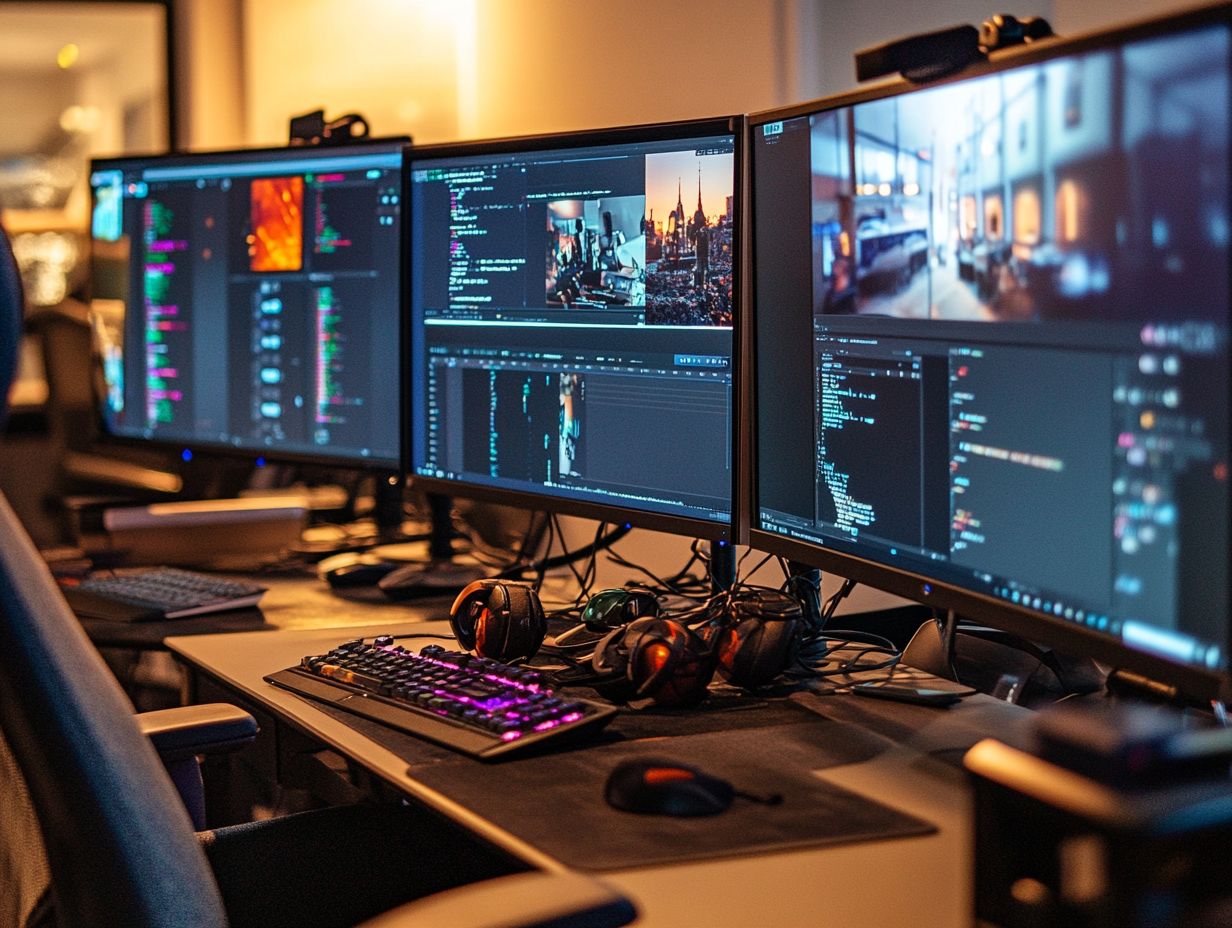
- Discover how a multi-display setup can transform your productivity!
- Consider factors such as screen size, resolution, connectivity, panel type, and refresh rate when choosing monitors.
- Improve display settings and calibrate colors and brightness for the best multi-display experience.
Understanding Multi-Display Setups
Grasping the importance of multi-display setups is crucial for anyone eager to elevate their digital workspace. This is especially true in fields like game development, where immersive experiences and seamless multitasking are key.
A well-designed multi-display configuration can turn an ordinary home office into a dynamic battle station. It fuels creativity and enhances efficiency.
By incorporating tools like a curved ultrawide monitor or a dual-screen setup, you can significantly enrich your user experience and boost productivity.
This transformation becomes essential for gamers, developers, or anyone engaged in writing or creative work.
What is a Multi-Display Setup?
A multi-display setup involves connecting multiple monitors to a single personal computer (PC). This significantly enhances your visual real estate and boosts workflow efficiency.
This arrangement is particularly favored by professionals needing a broad view for tasks like graphic design, programming, or stock trading. You can easily achieve various configurations, whether you prefer side-by-side displays, stacked monitors, or a grid layout.
The arrangement of your monitors is crucial, as it directly influences usability. Paying attention to factors like resolution, size, and orientation can greatly enhance your overall user experience.
Your display options range from traditional LCDs to sleek ultra-wide screens. Effectively managing this complex setup often requires specialized software. This software enables you to manipulate window placements, improve screen space, and streamline navigation between applications. This makes your work more efficient and enjoyable.
Benefits of a Multi-Display Setup
The advantages of a multi-display setup are profound. It provides heightened productivity and efficiency, especially in areas such as game design and digital workspace optimization.
Using multiple monitors offers a remarkable expansion of your screen real estate. This facilitates superior organization of application windows and boosts your multitasking capabilities.
A dual-screen setup or a curved ultrawide monitor creates an ergonomic workspace that reduces scrolling frustrations. This significantly enriches your experience during extended work or gaming sessions.
Increased Productivity and Efficiency
Increased productivity and efficiency are compelling reasons to embrace a multi-display setup. This is especially true if you’re involved in game development or managing extensive data for your writing projects.
With multiple screens at your disposal, you can easily monitor and interact with various applications simultaneously, cutting down the time wasted on window-switching.
Imagine this: as a game developer, you have your code editor open on one monitor while testing the game on another. This setup allows for real-time adjustments, resulting in a smoother workflow.
Writers can benefit similarly by displaying research materials alongside their writing software. This makes it easy to reference and iterate without missing a beat.
This enhanced desktop configuration not only streamlines your tasks but also minimizes distractions, enabling you to maintain focus and achieve more in less time.
Get Ready for an Exciting Gaming Experience!
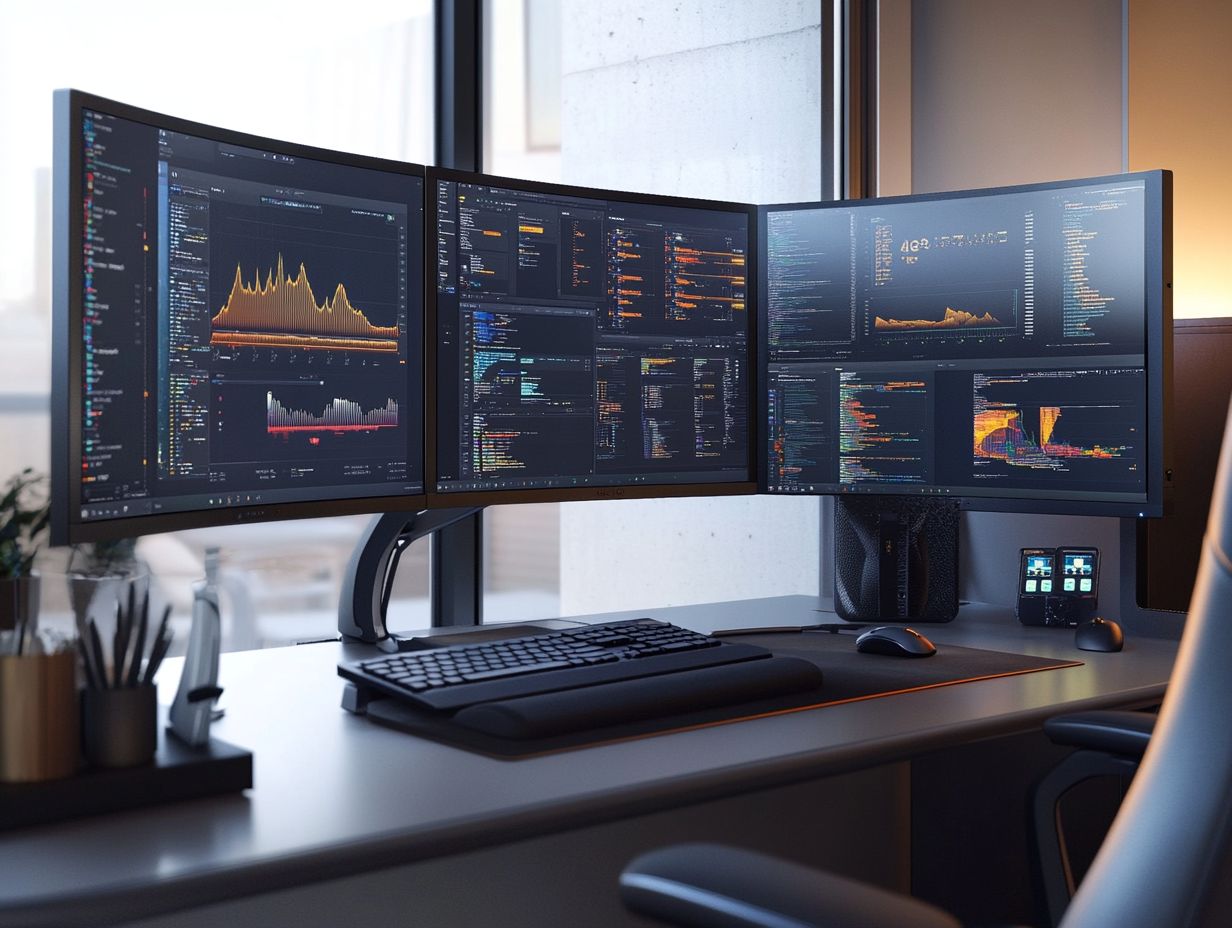
Experience an exciting gaming adventure with multi-display setups! These configurations transform a standard gaming session into a visual spectacle, immersing you in dynamic worlds crafted by cutting-edge graphics.
By using multiple flat-screen TVs or monitors, you create an expansive field of view that brings intricate details to life, from distant landscapes to real-time interface elements.
This setup enables seamless interaction with game mechanics, allowing you to gauge your surroundings and coordinate strategies clearly. A multi-display arrangement not only broadens your perspective but also amplifies your overall engagement, making each gaming adventure infinitely more exhilarating.
Factors to Consider When Choosing Monitors
When selecting monitors for your multi-display setup, consider several key factors:
- Screen size
- Resolution
- Connectivity options
- Panel type
- Refresh rate
These elements play a pivotal role in achieving optimal performance and an exceptional user experience. Evaluate these factors today for the best setup!
Screen Size and Resolution
The screen size and resolution of your monitors are crucial in determining the effectiveness of your multi-display setup. They influence everything from visual elements to user engagement.
A larger screen can enhance your immersion, especially in gaming, where every detail matters. Higher resolutions like 1440p or 4K offer sharper images that significantly improve visual clarity.
When tackling office tasks, a monitor with a higher resolution expands your workspace, allowing you to view multiple documents side by side without losing readability.
For optimal performance, choose monitors that align with your specific needs:
- Opt for larger, high-resolution displays for creative design work.
- Even dual monitors can streamline multitasking in a professional environment.
Calibrating color settings and adjusting the refresh rate can further boost usability and satisfaction, tailoring your setup to your requirements.
Connectivity Options
Connectivity options are crucial when setting up a multi-display configuration. They dictate how effortlessly your monitors connect to your PC and are recognized by the system.
Select the right ports HDMI, DisplayPort, or USB-C because they significantly impact not just the clarity of your displays, but also the responsiveness of your workflow.
- HDMI is popular for its commonality and ability to transmit audio signals.
- DisplayPort offers higher refresh rates and supports daisy chaining multiple monitors, making it ideal for power users.
- USB-C is a versatile option that provides both power delivery and video output in one sleek package.
Ensuring compatibility among all components helps you avoid issues like scrolling lags or resolution mismatches, resulting in a smoother user experience.
Panel Type and Refresh Rate
The type of screen technology and how often the screen updates the image (refresh rate) can dramatically influence your gaming and productivity experiences.
Understanding different panel technologies like IPS (In-Plane Switching), TN (Twisted Nematic), and VA (Vertical Alignment) is essential for optimal performance. IPS panels excel in color accuracy and offer wide viewing angles, making them a top choice for creative professionals.
Conversely, TN panels deliver faster response times, providing a crucial edge for competitive gamers. VA panels strike a balance with deeper blacks and superior contrast ratios, appealing to those who appreciate immersive visuals.
The refresh rate, measured in hertz (Hz), dictates how fluidly images are rendered on your screen. Higher rates, such as 144Hz or 240Hz, minimize motion blur and enhance the overall fluidity of your gaming experience.
By carefully considering these factors, you can configure your monitor to perfectly suit your specific needs.
Best Monitors for Multi-Display Setups
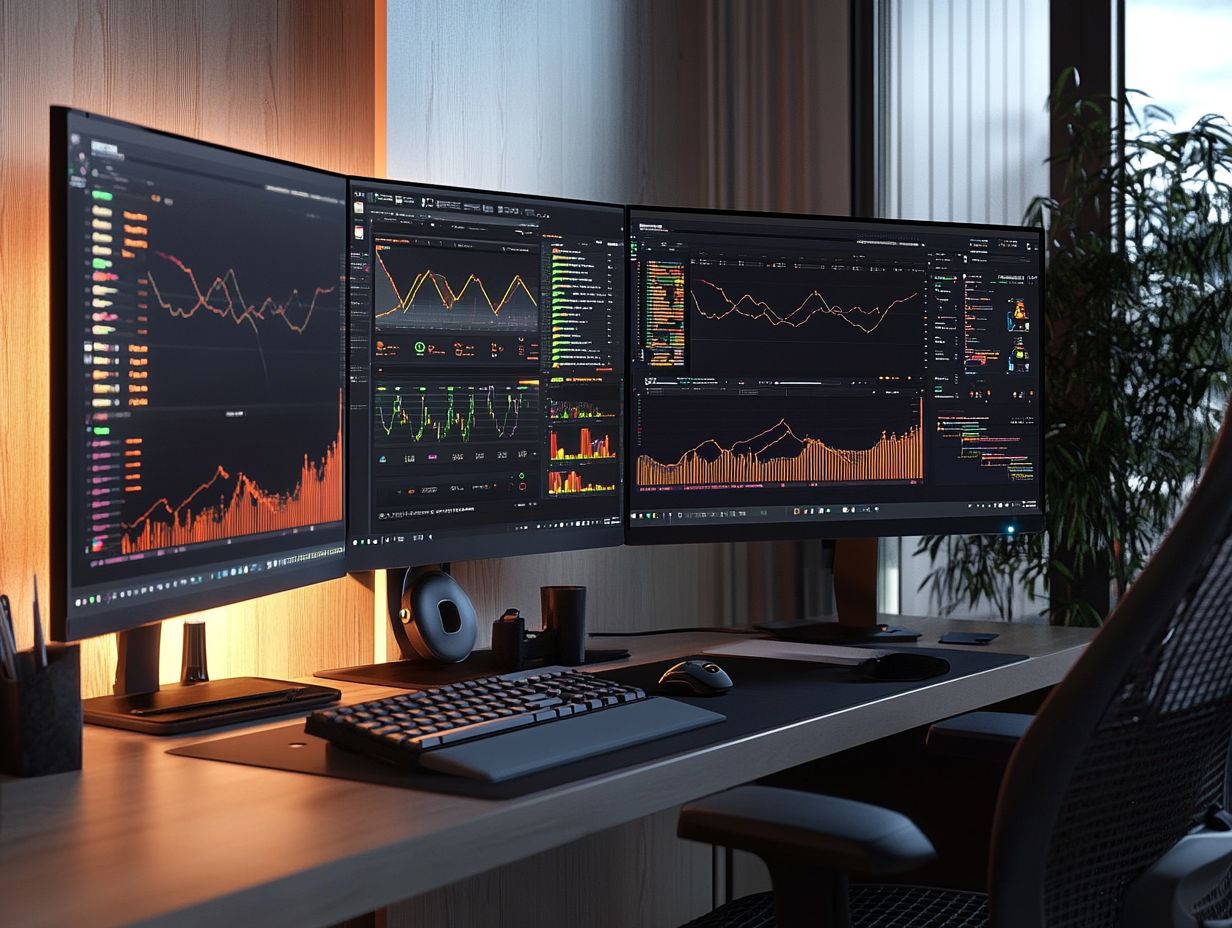
Choosing the right monitors for your multi-display setup is important. To enhance your gaming experience, learn how to connect multiple monitors for gaming. Assess your needs and budget carefully.
Prioritize having enough screen space to enhance your overall user experience.
Top Picks for Different Budgets
Here are some top-notch monitor options for your multi-display setups, curated across various budget ranges. Each option promises high resolution and features designed to elevate productivity and gaming experiences.
In the low-budget category, the Acer R240HY offers a crisp 1080p resolution and an IPS panel, which is a screen type that provides better colors from different angles. This is a fantastic starting point for dual monitor enthusiasts.
If you re looking into the mid-range market, the Dell UltraSharp U2415 stands out with its 1920×1200 resolution and adjustable stand. It ensures you can enjoy comfortable viewing angles during work or gaming sessions.
For those who demand the very best, the LG UltraGear 27GN950 is a true powerhouse with its impressive 4K resolution and 144Hz refresh rate. This makes it perfect for immersive gaming experiences that will leave you spellbound.
These selections cater to a variety of needs, guaranteeing seamless multitasking and exceptional visuals tailored just for you.
Tips for Setting Up and Configuring Monitors
Setting up and configuring your monitors effectively is essential for maximizing the benefits of a multi-display setup. Pay careful attention to resolution, cable management, and display scaling.
By addressing these elements, you can transform your workspace into a highly efficient environment that boosts productivity.
Optimizing Display Settings
Optimizing your display settings is crucial for enjoying the best possible experience from your multi-display setup, especially when using tools like the Nvidia control panel.
Adjusting the resolution and refresh rates can significantly enhance visual clarity and responsiveness. The experience becomes even more immersive when all displays are matched in their settings.
The Nvidia control panel offers intuitive options under the ‘Display’ section, allowing you to customize resolution and refresh rates according to your preferences. Achieving a symmetrical setup not only pleases the eye but also boosts productivity.
Make sure all monitors are set to the same resolution and similar refresh rates. This creates a seamless experience whether you re gaming, working, or multitasking across screens.
Calibrating Colors and Brightness
Calibrating colors and brightness on your monitors is essential for achieving monitor perfection. This ensures an optimal user experience, especially in a multi-display setup.
This process elevates visual aesthetics and guarantees consistent and accurate colors, which is crucial for graphic designers, photographers, and video editors.
To achieve effective calibration, use both software solutions and hardware tools.
- Software programs like Adobe Color and DisplayCAL enable precise measurement and adjustment of color settings.
- Hardware tools such as colorimeters provide accurate readings of your monitor’s output.
By maintaining uniform visual elements across your screens, you can create a seamless workflow that eliminates discrepancies, allowing your productivity and creativity to flourish.
Frequently Asked Questions
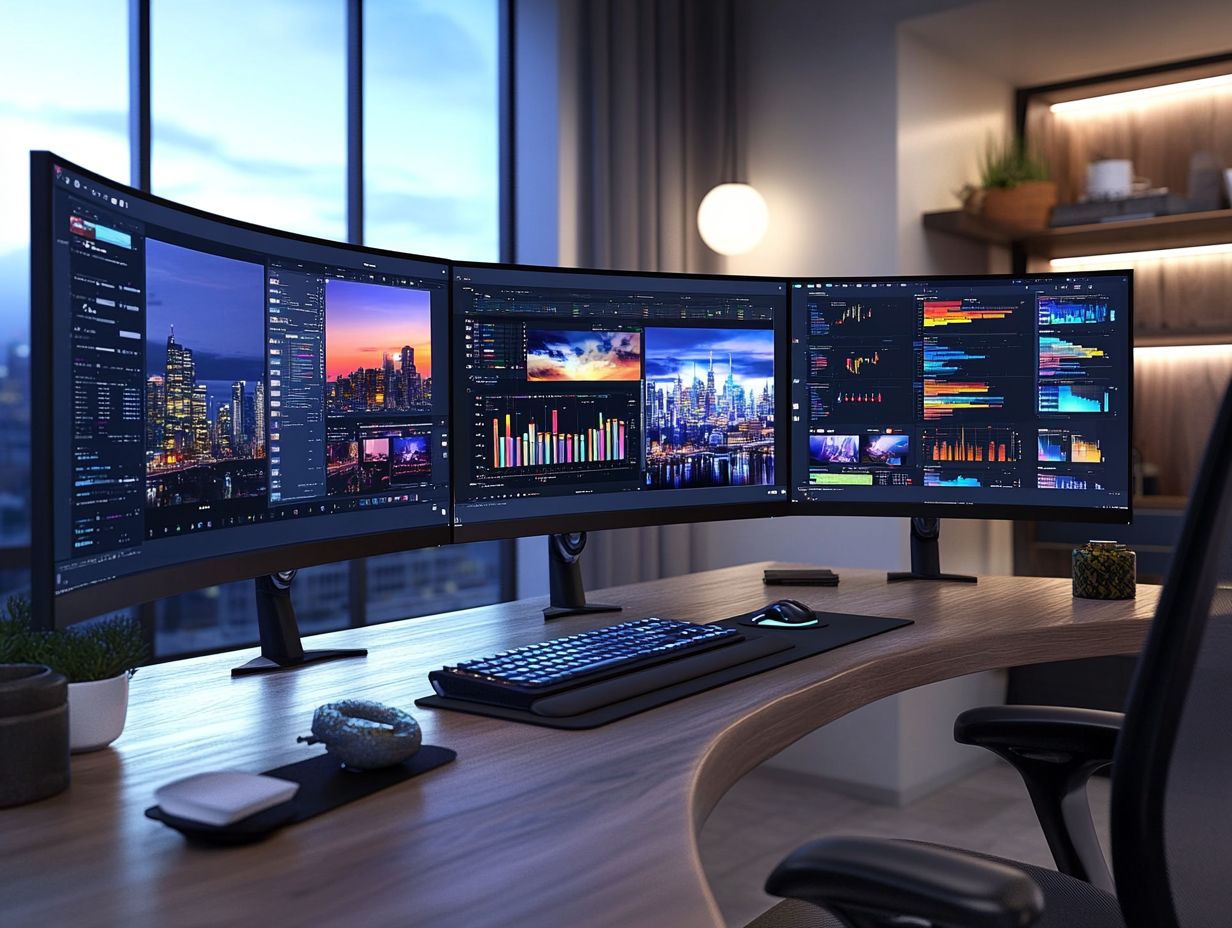
What factors should I consider when choosing monitors for a multi-display setup?
When choosing monitors, consider display size, resolution, connectivity options, and compatibility with your computer’s graphics card.
Do I need to have matching monitors for a multi-display setup?
While it is not necessary to have matching monitors, it is recommended for a consistent viewing experience. If you have different-sized monitors, you can adjust the display settings to accommodate them.
Can I mix different brands of monitors in a multi-display setup?
Yes, you can mix different brands of monitors if they have compatible ports and resolutions. However, using monitors from the same brand offers a smoother experience.
Do I need a special graphics card for a multi-display setup?
A graphics card that supports multiple displays is necessary. Check its specifications to confirm it can handle the number of monitors you want.
What is the recommended number of monitors for a multi-display setup?
The ideal number of monitors depends on your needs. Typically, two or three monitors work well, but some users prefer more for a bigger, immersive setup!
How do I set up my monitors for a multi-display setup?
First, connect your monitors to the computer with the right cables. Next, adjust the arrangement and orientation in your display settings for a personalized setup!

